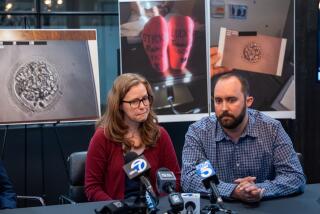Suit Over Cellular Radiation Raises Hazard Questions
- Share via
A Florida lawsuit has raised questions about the safety of portable cellular phones and whether their radiation emissions pose health hazards.
The suit, the first of its kind, charges that microwave radiation from a cellular phone contributed to, and perhaps even caused, the brain cancer that killed a young Florida mother. The tumor, located above and behind the victim’s left ear, grew to fatal proportions because the device “was equipped with an antenna so positioned as to cause exposure to microwave radiation” to that section of her brain, the suit says.
Stock prices of cellular firms plunged Friday. McCaw Cellular sank $2.125 to $36.375, Comcast lost 75 cents to $21.25, and Contel Cellular dropped $2.25 to $15.25.
Nonetheless, a Food and Drug Administration official said Friday that there is no reason for the government to issue health warnings about cellular phones, or even to call for additional study of potential risks. The phones in question are pocket-size portables with their own antennas, not models using antennas mounted outside vehicles.
The cellular industry contends that the suit’s allegations are the claims of a distraught widower, saying that no evidence exists to link portable phones to cancer. A spokesman for one of the defendants, GTE Mobilnet of Tampa Inc., said he could not comment on the lawsuit. “The claims in the lawsuit have absolutely no merit,” said Lourdes Cogswell, a spokeswoman for the other defendant, NEC America Inc.
Some scientists say evidence doesn’t exist because proper studies haven’t been done to confirm or deny suggestions of possible problems raised by preliminary research in the United States, Germany and England.
The allegations should be of particular interest in Southern California, whose 1 million portable phone users have made it the cellular capital of the world. Some scientists believe that anyone who uses new wireless communications technology should be aware that it poses still unanswered questions and unexplored potential hazards.
“The possibility of danger cannot be dismissed,” said Stephen Cleary, physiology and biophysics professor at Virginia Commonwealth University. His research has shown a connection between cancerous cell proliferation and exposure to microwave radiation at frequencies similar to those used by cellular phones.
“No one knows for sure how these low-energy fields of radiation can affect us. But we should know before we put this equipment next to our bodies.”
The suit comes as the telecommunications industry is preparing to launch the next generation of pocket-size, hand-held cellular phones. Businesses are looking at wireless phone networks to bring greater flexibility to their office communications systems.
Some scientists argue that before new wireless technology is adopted, it should be subjected to additional testing.
Mays Swicord, chief of the FDA’s radiation biology branch, agrees that conclusive studies do not exist. “Our data base is weak,” Swicord said. “There is reason to continue to watch this.”
The source of the latest controversy is a lawsuit filed last year by David Reynard, a Florida owner of a telephone paging service. The suit seeks unspecified damages against NEC America, a cellular phone manufacturer, and GTE Mobilnet, the cellular service provider.
In a video deposition made weeks prior to her death from a brain tumor, Susan Reynard blamed her illness on her usage of an NEC phone. Reynard said his 33-year-old wife used the phone an average of six to seven minutes per day in the last few years of her life. She died last May.






